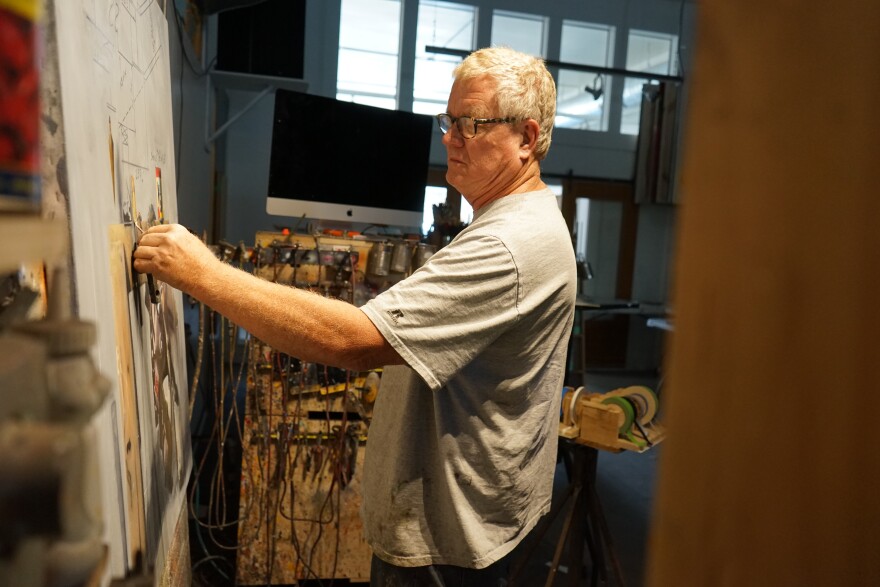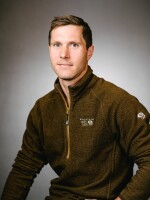HELPER — Standing in front of his half-finished oil painting of a coal mining crew, Thomas Williams gestured to the black-and-white photograph taped to the side of the stretched canvas.
Five coal miners pose in the underground darkness of the Hiawatha mine, southwest of town. Headlamps beam from their helmets in a photo taken almost 30 years ago.
“This is my last crew,” Williams said, who wore a “West Virginia coal miner” ballcap and a small pickaxe on a string around his neck. “The reason I took this picture is because it was the first time in a year-and-a-half we could stand up. For a year-and-a-half we was mining on our knees.”
That same year a mine cave-in buried Williams, ending a 15-year coal mining career in the area. Total hip and knee replacements followed, as well as years of opioid use to treat his pain.
Williams quit using opioids three years ago, cold turkey. “It was like hell,” he said. Others are not as lucky in Carbon County, an area that leads the state in opioid overdose deaths today.

Three years after the accident Williams’ began making art after his partner taught him to paint. His paintings of laborers, miners and railroaders were well received by local residents, he said. Williams’ success in the arts has paralleled a small artistic movement in this once economically depressed town of 2,000.
Like many struggling coal mining towns across the country, Helper and the surrounding Carbon County is often defined by the opioid epidemic. Residents of Helper hope the arts might be the key to changing that story.
“What saved this town really is the artists. And the people that come here that the artists brought,” said Williams, who is also the co-owner of Boxcar Gallery, one of about 10 galleries on Helper’s four-block mainstreet.
A Long Transition
Down the street from Boxcar Gallery, David Dornan stood in his cavernous workshop and gallery showing off his own oil painting — an image of a dresser, splattered with color. Stacks of paint cans and brushes covered the top and filled the drawers.
“It’s one of the tools that artists use,” Dornan said, “Instead of showing the finished painting that goes into the gallery, I’m showing them where it came from. That’s what I’m interested in.”

Dornan is regarded as the one resident who helped launch Helper’s art renaissance, after moving to town in the mid-1990s.
At the time he was an assistant professor at the University of Utah. He was teaching workshops and thought the historic town two hours south of Salt Lake City would be a good place to hold classes.
But Helper was struggling economically. Like the coal states of Appalachia, in the early 20th century Helper had a booming economy built on shipping coal from the nearby mines. At its peak there were around 20 mines in the area. Today there are just five, and many of the mining jobs have been automated. And like the economic struggles in Appalachia’s coal country, opioids filled the void.
Opioids got a foothold in Carbon County for several reasons, Williams with Boxcar Gallery said. Coal is an industry that’s hard on miners’ bodies and pain medicine helped people keep working. There was also drug abuse. Sporadic layoffs with the fluctuating industry led to stress and depression among family members, he said.
When Dornan learned about the city-owned two-story building on main street that would later become the gallery, he bought it for just $16,000. He was the only bidder.
In the years since, Dornan has led an influx of artists moving to town and buying storefronts to use as workshops and galleries. At first, residents didn’t embrace them with open arms. Over time, they came to appreciate each other more.

“Once the local people realized the artists weren’t against them; once these artists really got to know these people and really just put a name on them, instead of just an old coal miner or an old railroader, you saw the opioids just starting to disappear,” Williams, the former miner, said.
But they’re not totally gone. The opioid overdose rate in Carbon County was almost three times higher here than the rest of Utah, according to the most recent data from the state Department of Health.
Outside on main street Dornan pointed to a retro neon sign of a train locomotive, known as a “helper engine” and the town’s namesake, used to pull railcars over steep mountain passes. Dornan helped design it for the city.
“At night it’s beautiful. It’s got all these different colors of neon to it. Real neon. Here’s the one sign that’s been here since we’ve been here,” he said, motioning down the street. “The state liquor agency. That has not changed,” he said with a laugh.
Creative Placemaking
If hollowed out economies of natural resource towns are part of what’s behind the opioid epidemic, efforts like Helper’s are key to redefining the identity of rural communities, according to Michael Meit, co-director of the Walsh Center for Rural Health Analysis at the University of Chicago.
“There are a lot of communities around the country, including a lot of rural communities, that are embracing the arts as a way to redefine their communities,” Meit said.
The name for these efforts is creative placemaking. It means focusing on arts and culture to reinvigorate investment in local economies and revitalize communities.
“The last thing you want your community to be is the opioid capital of your state. And once you have that reputation, it is hard to bring investment into the community. So, by focusing on those assets, it invites people to come in and help redefine that narrative,” he said.
For Helper’s Mayor Lenise Peterman, “renaissance” and “reinvention” are words that come up often when giving a tour of the downtown strip.
She plans to use tourism as the first step to stabilizing Helper’s economy.

“Make it a place where people want to be and then let’s say to businesses, ‘Hey, your people want to live here.’ Let’s talk about how we can work together to rejuvenate some of the industries here in the area,” she said.
These days, historic building facades on Helper’s main street are lined by flower pots and benches. A new walking path and beach parallels the Price River where it passes through town, and a brewery is slated to open in town later this year.
The investments focused on Helper’s main street aren’t necessarily happening throughout the entire town. Tourism may not be the solution for other towns in Carbon County trying to re-energize their economies. But in Helper, they’re paying off. According to Peterman, these investments are creating a new sense of hope.
“If a community has hope there’s no stopping it,” she said. “If you have hope that we can do these things. We can get them done.”
The Opioid Misuse Assessment Tool was developed by the NORC University of Chicago and the U.S. Department of Agriculture's USDA Rural Development to map opioid overdose hotspots nationwide.


